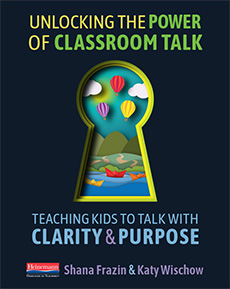Teaching Kids to Talk with Clarity and Purpose
Unlocking the Power of Classroom Talk: Teaching Kids to Talk with Clarity and Purpose
By Shana Frazin and Katy Wischow
(Heinemann Publishers, 2020 – Learn more)

On a typical day in my classroom, I will, at least once, ask my students to discuss with a partner or in small groups. I announce the topic then walk around to catch snippets of conversations, sometimes joining in.
In addition to the students who enthusiastically dive in, there are those who stay silent. There are others who talk, but not about the topic. There are many who nod and affirm the speaker but don’t add anything new to the conversation.

I decided it was time to rethink the role of partner and small group discussions in my classes, starting with the ideas I found in the book Unlocking the Power of Classroom Talk by Shana Frazin and Katy Wischow.
Foundations of Talk
This book is organized into three parts, beginning with Foundations of Talk. In that section Frazin and Wischow introduce classroom talk as a necessary skill that needs to be taught as a process or cycle. They draw a comparison to the way we teach writing.
In purposeful conversation we generate ideas, then we narrow our focus, choosing the topic of discussion. We then engage in the talk itself, developing and deepening our knowledge and understanding of the topic. The cycle culminates in action and reflection, often sparking more ideas and beginning the cycle again.
The explanations of each part of the cycle are accompanied by examples from the authors’ work with children in classrooms as well as in adult conversation.
Purposes of Talk
Part two, Purposes for Talk, opens with a prelude about reporting. When we ask students to discuss a topic, often they report instead, and the conversation quickly dies. Reading that introduction, it was as if the authors had visited my classroom, saw what was happening day-to-day, and understood my frustration.
They go on to share strategies to help students build their capacity to engage in four different types of talk – talking to build relationships, talking to play with ideas, talking to clarify, analyze, and argue – and, yes, talking to report.
Frazin and Wischow then devote a chapter to each type of talk, offering lots of examples and visuals that make their suggestions easy to try with confidence. In addition, readers can access an online resource that includes videos of strategies in action, PDF versions of materials, and video clips to use as mentor talks.
Leveling Up Your Talk
Frazin and Wischow compare the last section of their book, Leveling Up Your Talk, to a junk drawer in that it contains a number of useful items that don’t seem to fit anywhere else. There is a chapter on listening, one on assessment and celebration, and finally, one on troubleshooting classroom issues related to talk. Again, they offer concrete suggestions and examples in all of those areas.
As a 6th grade teacher tasked with making sure my students meet rigorous speaking and listening standards, I appreciated these chapters as they answered the questions that lingered after section two. When I read Tackling Talk Trouble, I had specific students and situations in mind and left those chapters feeling empowered to change what I thought was an inevitable struggle in my classroom.
New Perspectives on Teaching Conversation
When I started reading Unlocking the Power of Classroom Talk, I thought I might pick up some tips to make “turn and talk” moments in my classroom work better. Instead, I got new perspectives on teaching conversation as a skill and on using talk as a way to deepen knowledge in any subject area.
I teach Reading and Language Arts, but I was also drawn to the examples of how the strategies in this book can be applied in other subjects. Student talk, done this way, seems to lend itself easily to interdisciplinary work. I recommend this book to anyone who wants classroom conversation to be a powerful learning tool.
Karen Rubado has been working in education for over 25 years as a special education teacher, alternative education teacher, equity trainer, and in her current position as a 6th grade reading and language arts teacher. She lives in Minnesota with her husband and dog and serves as her local union president. She enjoys camping, snowshoeing, and hanging out with her two adult children.

































